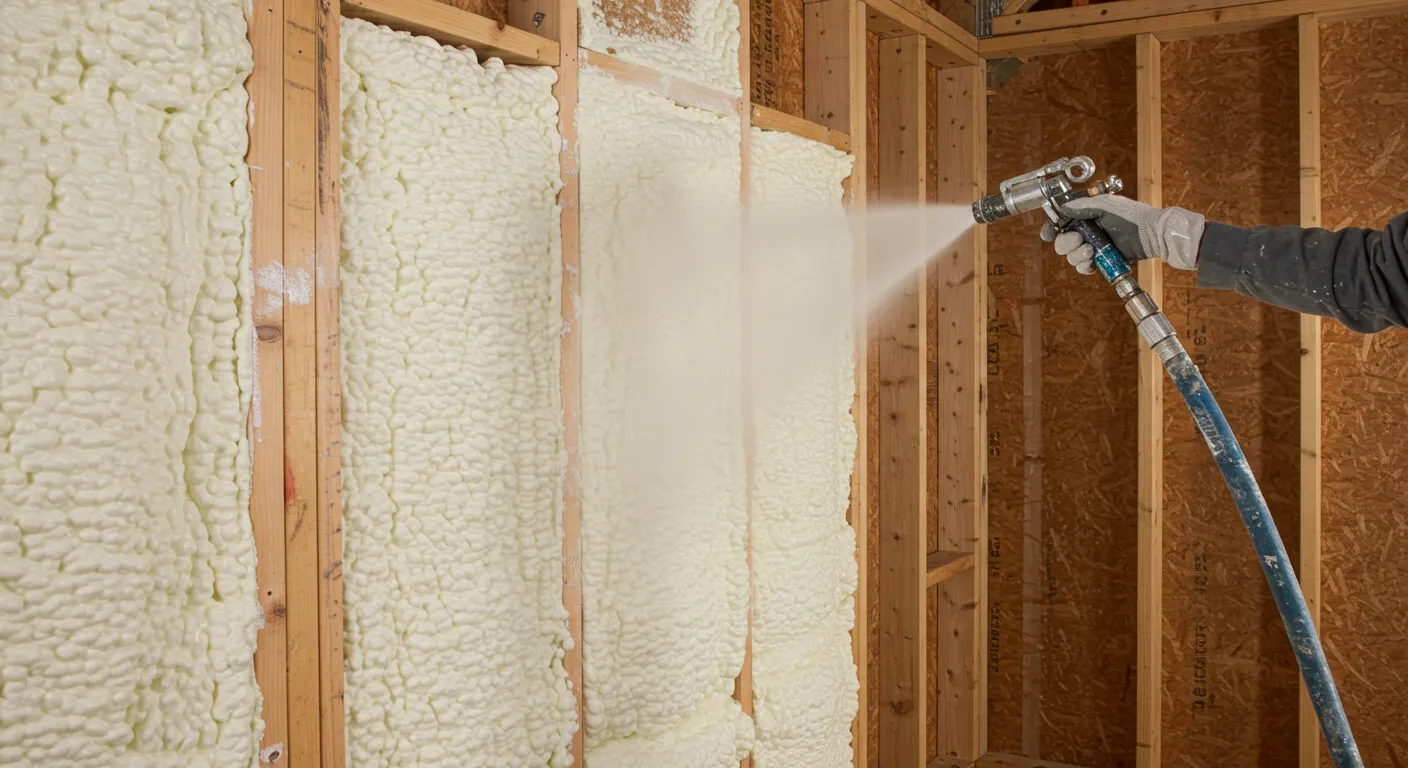Air leaks make homes uncomfortable, inefficient, and expensive to maintain. At Valley Spray Works, we talk to homeowners every day who are frustrated with fluctuating indoor temperatures, high utility bills, and persistent drafts that just won’t go away. They want more than temporary fixes they want lasting comfort and real control over their living environment.
That’s where open-cell spray foam insulation stands out. It doesn’t just insulate; it seals. And when installed by a team that understands how to apply it correctly like ours it transforms your home from a leaky structure into a tightly sealed, energy-efficient space.
In this guide, we’re walking you through exactly how open-cell spray foam achieves a reliable airtight seal and why it’s a smart choice for homeowners who want lasting results. You’ll come away knowing what it does, how it works, and how Valley Spray Works ensures it’s done right.
Why Air Leakage Happens in Homes And What Stops It
Every home has gaps tiny ones between studs, around window frames, in attic rafters, and beneath floors. Traditional insulation methods like fiberglass or cellulose can slow down air movement, but they rarely stop it. That’s a problem.
Open-cell spray foam behaves differently. It expands as it’s applied, filling every crack, joint, and cavity it touches. Instead of just sitting between materials, it bonds to them. Once cured, it forms a continuous, flexible air barrier.
At Valley Spray Works, we pay close attention to pressure differences in homes. That might sound technical, but here’s the point: warm air always wants to escape, and cold air wants in. We apply open-cell foam in strategic locations to neutralize that pressure drive, drastically reducing air infiltration.
Open-Cell Foam’s Expansive Seal: How It Works
The moment open-cell spray foam is applied, it begins to expand up to 100 times its liquid volume. This expansion allows it to reach deep into gaps and cavities that other materials miss. Once cured, it retains a spongy, semi-flexible form that adapts to building movement without cracking.
Because of its permeability, open-cell foam still allows for moisture vapor to pass through, which is ideal for applications where you want breathability without air exchange. Our crews understand the science behind this balance and apply it with purpose never guesswork.
Air Tightness Backed by Proper Installation
An airtight seal is only as good as the install. Our technicians are trained to identify and treat the most common leak-prone areas: attic slopes, rim joists, knee walls, and around mechanical penetrations.
We take our time with prep and walkthroughs before spraying begins. We check ambient conditions, substrate temperatures, and foam depth in real-time to ensure full performance. Every job is treated like it matters because it does.
The Real Impact: Energy Savings, Indoor Comfort, and Quieter Spaces
When spray foam insulation is properly installed, you feel the difference almost immediately. The air stops shifting. Your HVAC system doesn’t kick on as often. The temperature feels even—across rooms, floors, and seasons.
Homeowners often tell us they’re surprised by how quiet their home becomes after we’re done. That’s not an accident. Open-cell foam helps dampen airborne sound, reducing noise transmission through walls and ceilings.
We’ve seen heating and cooling bills drop by 30% or more after install. That’s not marketing fluff—it’s real feedback from clients across Idaho who chose to work with us.
Lower Energy Use, Smaller HVAC Loads
Open-cell spray foam limits the demand on HVAC systems. Because less air escapes and intrudes, your system works less to maintain indoor comfort. In many retrofit projects, we’ve helped homeowners downsize their HVAC equipment because it simply wasn’t needed anymore at the same capacity.
This not only reduces monthly utility bills it extends the lifespan of the equipment itself. It’s a compounding benefit that pays off year after year.
Whole-Home Consistency: No More Hot or Cold Rooms
Temperature imbalances are one of the top complaints we hear. One room is freezing while another feels stuffy. These issues are often tied to air leaks especially in older homes.
Spray foam corrects those inconsistencies by sealing the building envelope. The result? A home that feels even and predictable, regardless of where you are or what season it is.
Where It Matters Most: Strategic Areas for Foam Application
Not all parts of the home need the same type of insulation or the same approach. We help clients understand where open-cell foam delivers the highest value.
These include:
- Attic slopes and rooflines
- Wall cavities with plumbing or electrical penetrations
- Rim joists and crawl spaces
- Garage ceilings beneath living spaces
We analyze airflow, insulation history, and building structure to guide our spray foam placement. It’s this consultative approach that sets Valley Spray Works apart.
Precision in Hard-to-Reach Zones
Spray foam is particularly useful in awkward areas where traditional insulation is difficult to fit. We’ve insulated steep rooflines, irregular framing bays, and narrow attic accesses where batt insulation simply wasn’t effective.
Our application tools and experience allow us to be accurate, even when the job is challenging. We focus on coverage, depth consistency, and proper curing details that determine long-term results.
Retrofit or New Construction: We Know Both
We work with homeowners upgrading existing insulation as well as those building new. Each type of project has its own challenges, from venting adjustments to code requirements. We handle both with ease.
From pre-inspection to final walkthrough, we keep homeowners informed, involved, and confident in the results they’re getting.
Moisture and Mold Resistance with Air Sealing
One of the overlooked benefits of air sealing is how it reduces the chance of condensation and mold.
When air leaks through framing, it can carry moisture with it. That moisture settles on cool surfaces and becomes a breeding ground for mold and mildew especially in wall cavities you can’t see.
Open-cell foam slows down air movement so significantly that it cuts off this moisture pathway. It’s not a vapor barrier, but it is a highly effective moisture management tool when used strategically.
Preventing Moisture Transfer Through Walls
By stopping the flow of humid air into colder spaces, open-cell foam prevents condensation. That’s why it’s ideal for attic slopes and knee walls where seasonal differences in temperature and humidity clash.
We often pair open-cell spray foam with smart vapor retarders in high-humidity zones to create a balanced, breathable wall system.
Reducing Mold Risk Over Time
Less moisture intrusion means fewer mold triggers. If you’ve dealt with musty odors, cold walls, or visible mildew before, spray foam can be part of the solution.
Clients have reported major air quality improvements after insulation upgrades, especially in basements and attics where airflow was uncontrolled for years.
Your Path to a More Comfortable Home Starts Here
You deserve a home that stays warm in winter, cool in summer, and consistent all year round. Open-cell spray foam makes that possible. When applied with precision and care, it delivers results that last for decades.
At Valley Spray Works, we don’t just install insulation we solve problems. We take the time to understand your home’s challenges and apply solutions that make sense for you.
Whether you’re building new, upgrading old insulation, or just looking to get rid of those annoying drafts for good, we’re ready to help. Let’s make your home airtight—and finally comfortable.
Phone: (208) 490-9260
Email: [email protected]
Still Curious? Let’s Dive Deeper with Valley Spray Works
Q1: What’s the main difference between open-cell and closed-cell spray foam?
Open-cell foam is lighter, softer, and expands more, making it great for interior air sealing. Closed-cell foam is denser and better at moisture blocking and structural reinforcement.
Q2: Will spray foam really reduce my energy bills?
Yes, in most cases significantly. By reducing air leakage, your HVAC system doesn’t work as hard, which translates to measurable monthly savings.
Q3: Is it safe for homes with kids or pets?
Once cured, spray foam is inert and safe. We always follow strict ventilation and re-entry guidelines to protect household health.
Q4: How long does it take to install?
Most projects are completed in a day or two. Timing depends on the size of the home and accessibility of the areas being insulated.
Q5: Can I stay home during installation?
It depends on the scope. We’ll always advise you ahead of time on whether temporary relocation is needed during the curing period.
Q6: Does it help with noise?
Yes. Open-cell foam reduces airborne sound transmission, making your home quieter between rooms and from outside.
Q7: Where should it not be used?
We don’t recommend open-cell foam below grade or in areas with high water exposure unless paired with appropriate barriers.
Q8: Can it be added over existing insulation?
Usually, no. We typically remove old insulation to ensure proper adhesion and performance. We handle that process cleanly and safely.
Q9: Will it affect indoor humidity?
By reducing infiltration, it can help stabilize humidity levels indoors. Proper ventilation remains important, especially in sealed homes.
Q10: Do you offer assessments or estimates?
Yes we provide free consultations, in-home assessments, and clear estimates. Our goal is to give you all the info you need to make the best choice.



